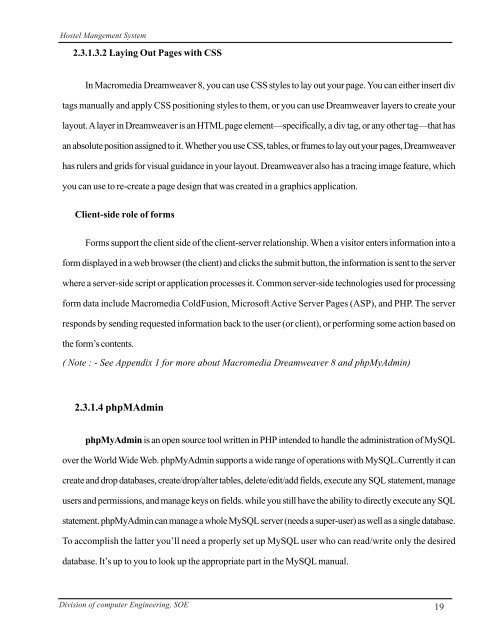hostel management system - DSpace at CUSAT - Cochin University ...
hostel management system - DSpace at CUSAT - Cochin University ...
hostel management system - DSpace at CUSAT - Cochin University ...
Create successful ePaper yourself
Turn your PDF publications into a flip-book with our unique Google optimized e-Paper software.
Hostel Mangement System<br />
2.3.1.3.2 Laying Out Pages with CSS<br />
In Macromedia Dreamweaver 8, you can use CSS styles to lay out your page. You can either insert div<br />
tags manually and apply CSS positioning styles to them, or you can use Dreamweaver layers to cre<strong>at</strong>e your<br />
layout. A layer in Dreamweaver is an HTML page element—specifically, a div tag, or any other tag—th<strong>at</strong> has<br />
an absolute position assigned to it. Whether you use CSS, tables, or frames to lay out your pages, Dreamweaver<br />
has rulers and grids for visual guidance in your layout. Dreamweaver also has a tracing image fe<strong>at</strong>ure, which<br />
you can use to re-cre<strong>at</strong>e a page design th<strong>at</strong> was cre<strong>at</strong>ed in a graphics applic<strong>at</strong>ion.<br />
Client-side role of forms<br />
Forms support the client side of the client-server rel<strong>at</strong>ionship. When a visitor enters inform<strong>at</strong>ion into a<br />
form displayed in a web browser (the client) and clicks the submit button, the inform<strong>at</strong>ion is sent to the server<br />
where a server-side script or applic<strong>at</strong>ion processes it. Common server-side technologies used for processing<br />
form d<strong>at</strong>a include Macromedia ColdFusion, Microsoft Active Server Pages (ASP), and PHP. The server<br />
responds by sending requested inform<strong>at</strong>ion back to the user (or client), or performing some action based on<br />
the form’s contents.<br />
( Note : - See Appendix 1 for more about Macromedia Dreamweaver 8 and phpMyAdmin)<br />
2.3.1.4 phpMAdmin<br />
phpMyAdmin is an open source tool written in PHP intended to handle the administr<strong>at</strong>ion of MySQL<br />
over the World Wide Web. phpMyAdmin supports a wide range of oper<strong>at</strong>ions with MySQL.Currently it can<br />
cre<strong>at</strong>e and drop d<strong>at</strong>abases, cre<strong>at</strong>e/drop/alter tables, delete/edit/add fields, execute any SQL st<strong>at</strong>ement, manage<br />
users and permissions, and manage keys on fields. while you still have the ability to directly execute any SQL<br />
st<strong>at</strong>ement. phpMyAdmin can manage a whole MySQL server (needs a super-user) as well as a single d<strong>at</strong>abase.<br />
To accomplish the l<strong>at</strong>ter you’ll need a properly set up MySQL user who can read/write only the desired<br />
d<strong>at</strong>abase. It’s up to you to look up the appropri<strong>at</strong>e part in the MySQL manual.<br />
Division of computer Engineering, SOE 19
















